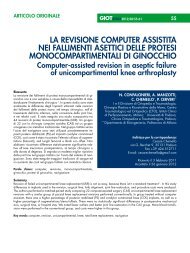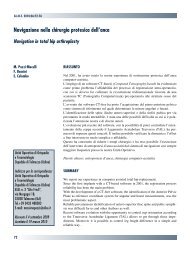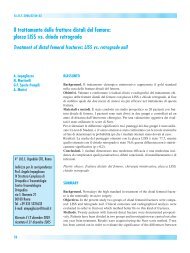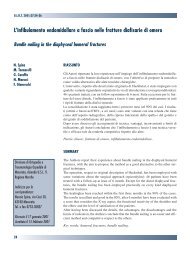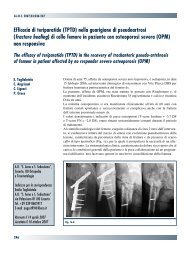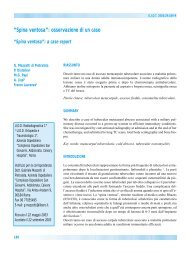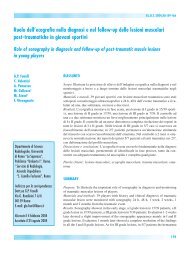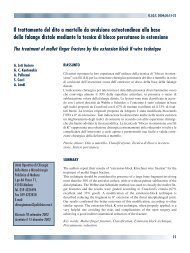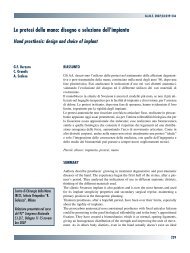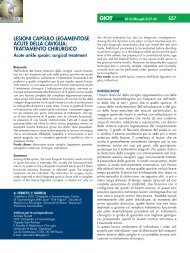30845 Suppl Giot.pdf - Giornale Italiano di Ortopedia e Traumatologia
30845 Suppl Giot.pdf - Giornale Italiano di Ortopedia e Traumatologia
30845 Suppl Giot.pdf - Giornale Italiano di Ortopedia e Traumatologia
Create successful ePaper yourself
Turn your PDF publications into a flip-book with our unique Google optimized e-Paper software.
G.I.O.T. 2010;36(suppl. 1):S140<br />
Chitosan for cartilage defects<br />
Chitosano nei <strong>di</strong>fetti cartilaginei<br />
F. Forriol<br />
Chitosan is a linear polysaccharide composed of randomly<br />
<strong>di</strong>stributed D-glucosamine (deacetylated units) and N-acetyl-Dglucosamine<br />
(acetylated units), soluble within an acid environment.<br />
When its deacetylation degree is less than 60%, it is then<br />
called Chitin. The latter is the second most abundant natural<br />
polymer on earth after cellulose. Chitosan has a great variety of<br />
applications in several fields, the biome<strong>di</strong>cal one being of the latest<br />
and more promising among them. It can be worked out so as to<br />
have the product available in various forms such as nanoparticles,<br />
microspheres, hydrogels, films, fibers or enteric coats.<br />
Its cationic nature gives Chitosan an interesting property, namely the<br />
ability to adhere to negatively charged surfaces such as living tissues<br />
and mucosal membranes, allowing also the transport of polar substances<br />
such as drugs across epithelial surfaces 1 . When it breaks down,<br />
the byproduct is composed from chains of glucosamine, a natural component<br />
of tissues such as articular cartilage. Its toxicity is almost null,<br />
making it a highly biocompatible and biodegradable substance.<br />
Wound healing is one of the most popular uses for Chitosan in<br />
the biome<strong>di</strong>cal field. Some of the reasons which make Chitosan<br />
based products so suitable for this use are its haemostatic capabilities<br />
2 , its anti-inflammatory effects 3 4 , a proven antimicrobial<br />
action 4 , and the ability to retain or attract some growth factors<br />
which are part of the healing processes 5 .<br />
More advanced uses of Chitosan such as for articular cartilage<br />
repair or gene therapy processes 6-8 are being stu<strong>di</strong>ed presently<br />
with very encouraging results so far. Applications such as bone<br />
regeneration, alone or in combination with more substances (like<br />
calcium phosphate) are also being tested presently 1 .<br />
One of the drawbacks of Chitosan has to deal with the fact that it<br />
is soluble only within acid environments that are beyond physiological<br />
levels. Some constructs have being used to overcome<br />
this problem, making its use possible at a liquid state, and thus<br />
enhancing its parenteral and local delivery capabilities. It can be<br />
used also as a thermogel, with the ability to be delivered in liquid<br />
form and then using the body temperature to transform itself into<br />
a gel with <strong>di</strong>fferent residency time frames as well as <strong>di</strong>fferent<br />
mechanical properties 9 . They are applied as space-filling agents,<br />
delivery vehicles for bioactive molecules and as three <strong>di</strong>mensional<br />
structures. They act as biodegradable scaffolds that can support<br />
the repair or regeneration of a new tissue. This application is<br />
being tested presently in clinical trials for cartilage repair.<br />
As more research is being conducted, more surprising roles for a<br />
polysaccharide like Chitosan are being <strong>di</strong>scovered, especially in<br />
the biome<strong>di</strong>cal field. It use is expected to keep on growing in the<br />
coming years.<br />
Madrid, Spain<br />
S140<br />
In clinical practice, microfractures, MSC and blood from the spongy<br />
metaphyseal bone are lost in the joint, and the injury is repaired with<br />
fibrocartilage, a tissue that is ill suited to bearing mechanical loads.<br />
To prevent this, an effective low-cost solution is to cover the area of<br />
the injury that has been perforated with an adhesive polymer, could<br />
be chitosan, so that the blee<strong>di</strong>ng, with its cells and growth factors,<br />
is soaked up by the polymer to achieve what has been described as<br />
ICI (in situ chondro-induction), using the chitosan as a scaffold that<br />
prevents the blood clot from retracting, thus filling the defect and<br />
staying in place; as this scaffold is cationic, it establishes a strong<br />
adherence to the walls and floor of the lesion, which are anionic. It<br />
also protects the blood platelets, keeping their normal functionality<br />
(releasing the various growth factors needed to trigger the inflammatory<br />
response, among them the PDGF), and maintaining their levels<br />
for a longer period of time. With this and other effects, the basis for<br />
what is called SGRM (Scaffold Guided Regenerative Me<strong>di</strong>cine), is<br />
set, complemented with the already mentioned ICI 7 .<br />
There a lot yet to be done, but repair of the avascular tissues poses many<br />
<strong>di</strong>fficulties, and it will be necessary to explore these potential options<br />
carefully and proceed by means of elimination, in order to reach the<br />
solution that all of us desire. One that will be cost - effectivity, produces<br />
the right target tissue and is surgically attainable by the average<br />
surgeon. That would be the true innovation that the orthopae<strong>di</strong>c community<br />
is looking for to solve the problem of secondary osteoarthritis<br />
and its increasing burden on the health systems around the world.<br />
rEFErENCES<br />
1 Di MA, Sittinger M, Risbud MV. Chitosan: a versatile biopolymer for<br />
orthopae<strong>di</strong>c tissue-engineering. Biomaterials 2005;26:5983-90.<br />
2 Pusateri AE, McCarthy SJ, Gregory KW, et al. Effect of a chitosan-based<br />
hemostatic dressing on blood loss and survival in a model of severe venous<br />
hemorrhage and hepatic injury in swine. J Trauma 2003;54:177-82.<br />
3 Ho EA, Vassileva V, Allen C, et al. In vitro and in vivo characterization of a<br />
novel biocompatible polymer-lipid implant system for the sustained delivery<br />
of paclitaxel. J Control Release 2005;104:181-91.<br />
4 Shi Z, Neoh KG, Kang ET, et al. Antibacterial and mechanical properties of bone<br />
cement impregnated with chitosan nanoparticles. Biomaterials 2006; 27:2440-9.<br />
5 Amaral IF, Granja PL, Barbosa MA. Chemical mo<strong>di</strong>fication of chitosan by<br />
phosphorylation: an XPS, FT-IR and SEM study. J Biomater Sci Polym Ed<br />
2005;16:1575-93.<br />
6 Guo T, Zhao J, Chang J, et al. Porous chitosan-gelatin scaffold containing<br />
plasmid DNA enco<strong>di</strong>ng transforming growth factor-beta1 for chondrocytes<br />
proliferation. Biomaterials 2006; 27:1095-103.<br />
7 Hoemann CD, Hurtig M, Rossomacha E, et al. Chitosan-glycerol phosphate/<br />
blood implants improve hyaline cartilage repair in ovine microfracture<br />
defects. J Bone Joint Surg Am 2005;87-A:2671-86.<br />
8 Chevrier A, Hoemann CD, Sun J, et al. Chitosan-glycerol phosphate/<br />
blood implants increase cell recruitment, transient vascularization and<br />
subchondral bone remodeling in drilled cartilage defects. Osteoarthritis<br />
Cartilage 2007;15:316-27.<br />
9 Chenite A, Chaput C, Wang D, et al. Novel injectable neutral solutions of<br />
chitosan form biodegradable gels in situ. Biomaterials 2000;21:2155-61.



